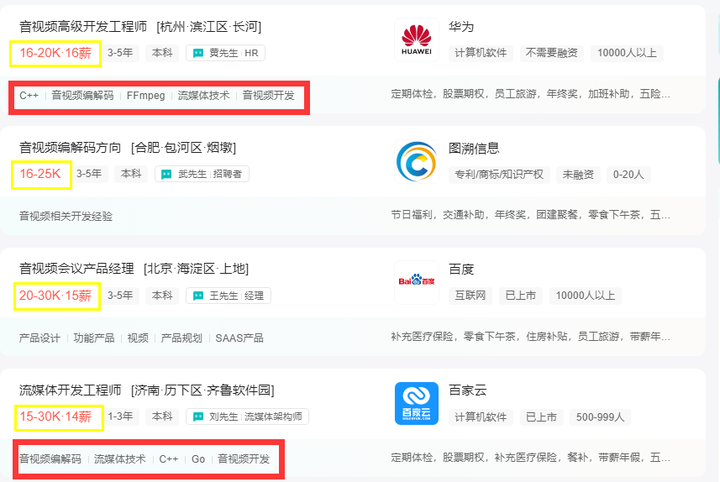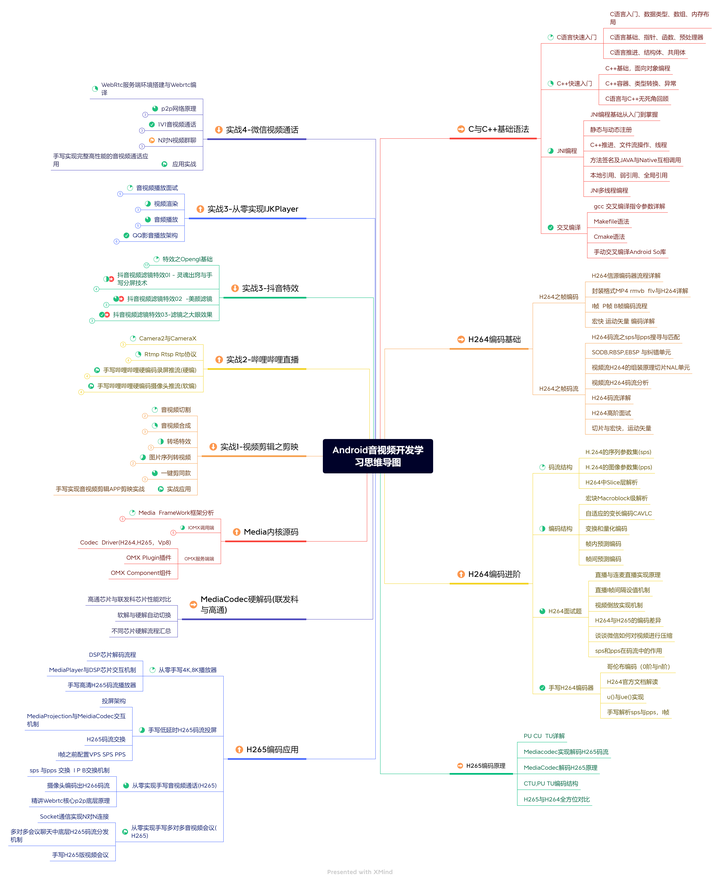foreword
As a high-tech field, audio and video development has a very bright prospect as people's demand for digital media continues to increase. It is expected that in 2023, the field of audio and video development will continue to maintain a rapid development trend, especially in the fields of mobile Internet, Internet of Things, virtual reality, and augmented reality.
According to the data analysis of the BOSS recruitment website, the salaries of audio and video development related positions are generally relatively generous. For example, the salary of ordinary audio and video development engineers recruited by BOSS on the Internet is generally between 10K-20K in first-tier cities, and senior audio and video development engineers can even get a salary of 30K-50K.

In addition, the field of audio and video development also has high requirements for technical ability and experience, so you need to be fully prepared and show your technical strength and experience in the interview. It is best to master common audio and video codecs, protocols, and common development tools and frameworks, such as FFmpeg, GStreamer, OpenCV, Android MediaCodec, etc., which will help improve your competitiveness.
Audio and video common 50 interview questions
- What are audio and video codecs?
- What are the common audio and video encoding formats?
- What is rate control? What are the common rate control algorithms?
- What are I frames, P frames, and B frames?
- What is audio and video synchronization?
- What is an audio and video container format?
- What are the common audio and video container formats?
- What is the audio and video sampling rate?
- What is the audio and video frame rate?
- What is the audio bit rate?
- What is video bit rate?
- What is audio and video resolution?
- What is audio and video streaming?
- What is the RTMP protocol?
- What is the HLS protocol?
- What is the UDP protocol?
- What is the RTP protocol?
- What is the RTSP protocol?
- What is audio and video capture?
- What are the common audio and video capture devices?
- What is audio and video processing?
- What are the common audio and video processing tools?
- What are audio and video clips?
- What is Audio Video Synthesis?
- What is audio and video transcoding?
- What is audio and video decoding?
- What is audio and video rendering?
- What is audio and video playback?
- What are the common audio and video players?
- What is audio and video streaming?
- What is audio and video streaming?
- What are the common audio and video streaming servers?
- What is audio and video cloud service?
- What are the common audio and video cloud service providers?
- What is WebRTC?
- What is ffmpeg?
- What is libavcodec?
- What is Android MediaCodec?
- What is iOS AVFoundation?
- What is DirectShow?
- What is GStreamer?
- What is OpenGL ES?
- What is OpenAL?
- What is SDL?
- What is FFPlay?
- What is VLC?
- What is MPlayer?
- What is Flash Player?
- What is Silverlight?
- What is HTML5 Video?
These questions cover different areas of audio and video development, from theory to practice, from encoders to decoders, from protocols to tools, from devices to cloud services, etc. Familiarity with these issues will help candidates understand audio and video development more comprehensively and demonstrate their technical level.
Audio and video learning from 0 basics
Data reference: "Audio and Video from 0 to 1 Core Technology Manual"
To become a qualified audio and video development engineer from 0 basics, you need to master the following core technologies:
- Basic mathematical knowledge: Basic mathematical knowledge such as matrix, transformation, sampling, filtering, and signal processing is the foundation of audio and video development.
- Principles of codecs: Understand the working principles of codecs, as well as the characteristics, advantages and disadvantages of common codecs.
- Multimedia container formats: Master the characteristics and usage of multimedia container formats, as well as common container formats such as MP4, AVI, MOV, MKV, etc.
- Audio and video collection: Master the principles and implementation methods of audio and video collection, including the use of microphones and cameras, as well as the collection, processing and encoding of audio and video.
- Audio and video processing: Master the technologies and tools of audio and video processing, including audio and video editing, synthesis, transcoding, etc.
- Audio and video playback: Master the principles and implementation methods of audio and video playback, including audio and video decoding, rendering, synchronization, etc.
- Audio and video streaming media transmission: Master the technologies and protocols of audio and video streaming media transmission, including RTMP, HLS, UDP, etc.
The learning steps can be followed in the following steps:
- Learn basic mathematical knowledge, and master basic knowledge such as matrix, transformation, sampling, filtering, and signal processing.
- Learn the principles of codecs, understand how codecs work, and the characteristics, advantages and disadvantages of common codecs.
- Learn multimedia container formats, master the characteristics and usage of multimedia container formats, and common container formats such as MP4, AVI, MOV, MKV, etc.
- Learn audio and video capture, including the use of microphones and cameras, as well as the capture, processing and encoding of audio and video.
- Learn audio and video processing, master audio and video editing, synthesis, transcoding and other technologies and tools.
- Learn audio and video playback, including audio and video decoding, rendering, synchronization, etc.
- Learn audio and video streaming media transmission, master audio and video streaming media transmission technologies and protocols, including RTMP, HLS, UDP, etc.

Summarize
Audio and video development is a broad field, covering multiple links such as audio and video acquisition, processing, encoding, decoding, transmission, rendering, and playback. In the development of audio and video, it is necessary to master the basic theory of audio and video, audio and video processing and codec algorithms, audio and video transmission protocols, audio and video rendering technology, development of audio and video players, audio and video cloud services and other aspects of knowledge.
For beginners, you can first understand the basics of audio and video, such as audio and video capture equipment, audio and video capture process, audio and video codec algorithm, audio and video container format, etc. Then you can learn common audio and video programming frameworks and tools, such as ffmpeg, GStreamer, DirectShow, AVFoundation, etc.
For developers who want to learn more, it is necessary to conduct in-depth research on audio and video codec algorithms, audio and video transmission protocols, audio and video rendering technologies, such as learning H.264, H.265, AAC and other codec algorithms, learning RTMP, HLS, WebRTC and other transmission protocols, learning OpenGL ES, OpenAL, SDL and other rendering technologies. In addition, it is also necessary to understand the development and application of audio and video cloud services, such as cloud live broadcast, cloud recording, cloud transcoding, etc.
In short, audio and video development is a wide-ranging, deep and complex field, which requires continuous learning and practice, mastering technologies and tools in different fields, in order to become a qualified audio and video development engineer.